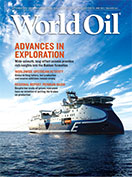Issue: September 2015
Special Focus
Land seismic innovations, such as the affordable acquisition of wide-azimuth, long-offset data, coupled with offset and azimuthally friendly processing, provide rich insights into the Bakken formation.
Newly reprocessed vintage seismic data, covering an area rich with discoveries, offers operators the chance to capitalize on an under-explored area offshore West Africa.
Features
An operator in Australia wanted to assess the potential of a well while drilling with oil-based mud. Conventional coring was cost-prohibitive, and existing imaging tools were not suitable for the large borehole size. A new, specially designed imager was used to achieve impressive results.
Low oil prices are constricting drilling activity worldwide with a couple of exceptions. Meanwhile, production and reserve levels have gained, spurred by last year’s stout drilling effort.
What does it mean for production, markets, and investment opportunities?
Wireless networks are changing the way that producers look at wellsite optimization. And in the Bakken shale, where operating conditions are among the most difficult in the world, a pilot test conducted by WPX Energy showed how wireless is increasingly becoming a preferred method.
One of the larger petroleum industry conferences and exhibitions in the U.S., the Louisiana Gulf Coast Oil Exposition (LAGCOE) will celebrate 60 years during Oct. 27-29. Once again, the three-day biennial event will take place at the Cajundome & Convention Center in Lafayette, La. It drew more than 17,000 attendees in 2013. Once again, admission to the 2015 show is free, but limited to industry personnel.
Memo to bulls-in-waiting: If your recovery models are built around operators in the Permian basin choking down the spigot, now would be a good time to recalibrate.
FactoryTalk software, virtual servers replace aging human-machine interface infrastructure as part of multi-facility upgrade, which saved the operator considerable expense.
Columns
The tragedy of us vs. them
They come out at night
So, what to do now?
New takes on rig floor PPE
Can you give me a lift?
Signs of the times
Russia: Time of choices
Slow uptake of new technologies: Is the criticism justified?
Wallace E. Pratt: In the minds of men
Additions to U.S. oil reserves from Shale Revolution remain impressive
News & Resources
World of oil and gas
Industry at a glance
People in the industry
New products and services
Companies in the news
ShaleTech Report
How do you maintain profitability when the crude oil price drops by 60%? For some highly leveraged shale oil and gas operators, the end is near.
Studies in the Eagle Ford shale show that flow-channel fracturing delivers gains in oil and gas production and recovery while reducing water and proppant usage.
Pressure-dependent SRV regions take shape during water injection in the fracturing process and reduce in size during production. Pressure depletion shows that there is a significant amount of oil saturation left between the fractures. This provides the rationale for refracturing between existing fractures.
Solid expandable liners provide positive mechanical isolation of old perforations and enable the fracturing of new reservoir rock. These liners have robust mechanical ratings that often exceed the casing that they are being expanded into, and provide maximum ID to permit continuation of planned completion activities.
ShaleTech news



